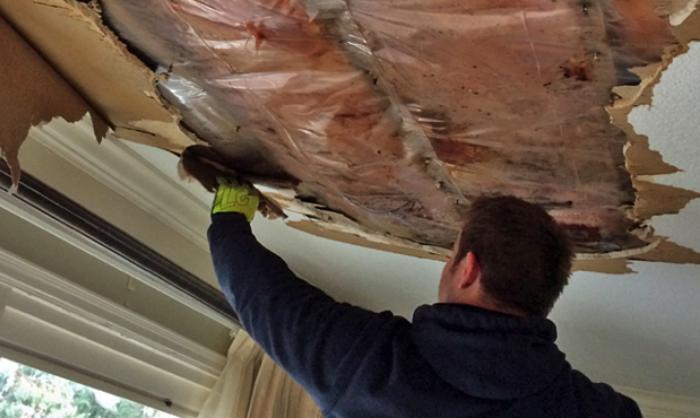Wet Drywall
Drywall, or sheetrock as it’s also called, is a layer of gypsum sandwiched between two sheets of paper. The key to the durability of drywall is the gypsum rock that forms the sheet. A core of wet plaster between two sheets of heavy paper, once set and dried, produces a strong, rigid building material.
Too much water can cause the core of the drywall to break down and the paper to separate from the core. Sheetrock doesn’t handle getting wet very well and depending on how wet it got during the water damage, the sheetrock may have been weakened beyond the point of being salvaged.
If the water drained off and the area was dried out quickly, then the sheetrock is likely okay, but be vigilant and keep an eye out for any signs of mold, as it can be a health hazard and lead to further damage. However, if water is being held against the sheetrock and the wood studs or was absorbed into the wall, then you could have trouble with warping, mold and rot.
Water damaged drywall ceilings
You may not think that much water leaked, but it doesn’t take much to create a disaster. The weight of the water and loss of structural integrity of the gypsum core causes the drywall panels to tear away from the fasteners. It usually happens without notice and the entire drywall ceiling crashes to the floor.
The first signs that your ceiling is in danger of falling are depressions around the fasteners. You’ll see small dimples form as the drywall surrounding the nails or screws succumbs to gravity and starts to droop, leaving an upside-down crater. If you see this happening, move all valuables and furniture from the room in anticipation of a ceiling collapse.

If a bubble or droop appears in the drywall, water could be ponding on the other side. Use a nail to punch a drain hole, allowing the water to escape. Capture it with a bucket. Feel the ceiling with your fingers, if it’s hard and doesn’t easily dent, you may have dodged the bullet. But if the drywall seems soft or spongy, you’re best bet is having the damaged sections removed before they sag and possibly fall. Call Water Damage Minneapolis™ and we will be there to take care of all the restoration repairs and remodeling for you.
Drywall water damage after a house fire
First off, you need to determine the extent of the water damage your drywall was subjected to. Drywall water damage manifests itself as discolored or softened areas. For example, if you had a house fire, chances are that all the water used to extinguish the fire and save your house may have also caused widespread damage to your drywall. If so, you need to call Water Damage Minneapolis™.
The hidden danger that lies within
If water damage has compromises your drywall, you must take care of it before mold or mildew develop, which can be dangerous and cause even more damage. Mold spores are hidden amongst the dust and organic matter in most ceilings, just waiting for the right combination of warmth and moisture to make them grow. The only ingredient missing was water, and now that’s present so mold spores can bloom within days if you don’t act.
If you do not adequately dry the sheetrocked walls, mold and mildew may develop, which is not good for you or your family. If you see black spots or if the area starts to emit an odor, you’ve got problems. Mold and mildew occur most frequently when damp drywall sits with inadequate ventilation. Though you can ensure that mold or mildew does not grow on the exterior of the drywall, the interior ceilings and walls may be covered with mold spores.
Don’t allow anything to dry out on its own if you had standing water in your home. Standard oscillating house fans do not move an adequate amount of air necessary to dry the room adequately. The most important thing to remember if you’ve had drywall water damage is to act immediately to prevent additional damage from mold or mildew. Call Water Damage Minneapolis™ so we can open up the area by removing the wet drywall and bring in our industrial strength air movers and dehumidifiers to get everything completely dried out, so you avoid mold damage.
Water Damage Minneapolis™ is ready to come to your rescue!
Call 763-242-2103 now or send us an email: help@waterdamageminneapolis.us